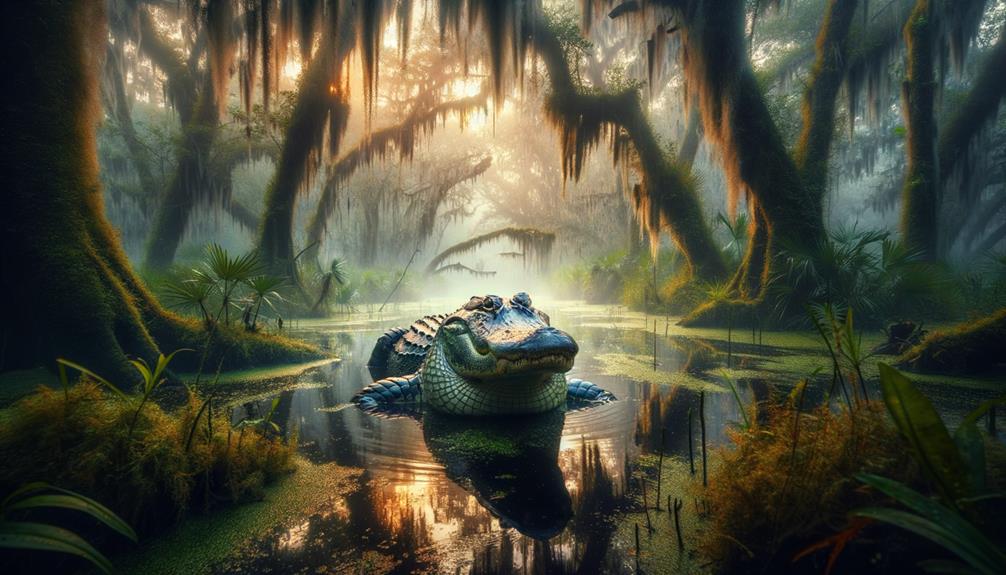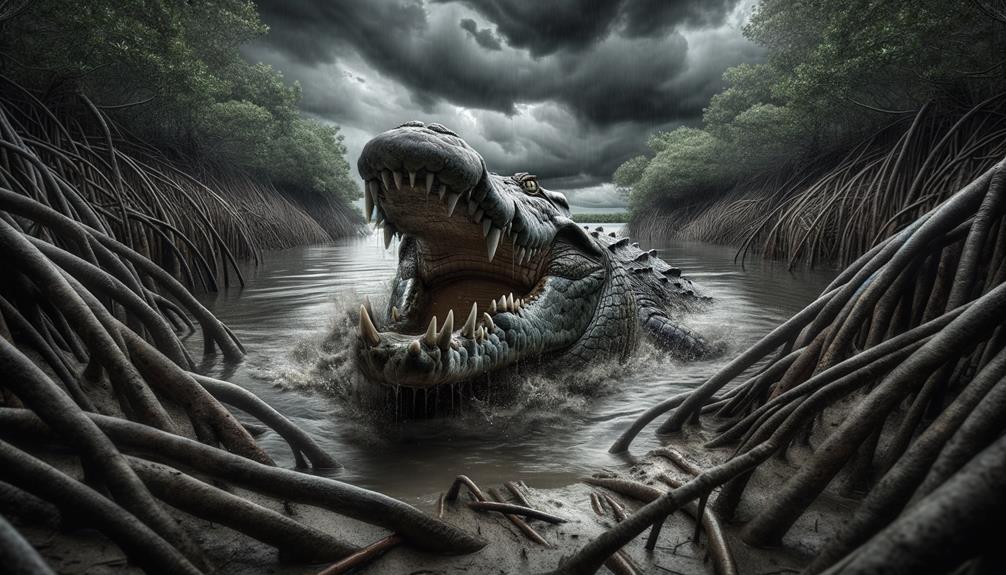Dwarf crocodiles are the hidden gems of the forest, thriving in densely forested riverine habitats of tropical South America. With their distinctive dome-shaped skulls and upturned snouts, they navigate the dense foliage with ease. These fascinating reptiles grow up to 1.6 meters and are protected by armor-like scales. They’re opportunistic feeders, dining on a diverse menu that includes fish and small mammals. During the dry season, they conserve moisture by aestivating in burrows. Conservation efforts, such as captive breeding and anti-poaching patrols, are crucial for their survival. To truly appreciate these forest jewels, you’ll want to delve deeper into their captivating world.
Key Takeaways
Dwarf crocodiles inhabit the dense, tropical forests of northern and central South America, where they thrive in riverine habitats. Their distinctive dome-shaped skull and upturned snout allow them to move efficiently through dense vegetation. These carnivores feed on a diverse range of prey, including fish, amphibians, small mammals, birds, crustaceans, and insects. Due to habitat loss and hunting, dwarf crocodiles are classified as Vulnerable, prompting conservation efforts such as captive breeding programs, anti-poaching patrols, and habitat preservation. At The Living Rainforest, visitors can observe dwarf crocodiles and other species in their natural habitat, gaining a deeper appreciation for these remarkable creatures.
Unique Habitat
Tucked away in the lush, tropical northern and central regions of South America, dwarf crocodiles thrive in the forested riverine habitats and flooded forests surrounding lakes. As someone who has ventured into these vibrant ecosystems, I can vouch for the unique beauty and complexity of their habitat. These species favor fast-flowing rivers and streams, often found in the nutrient-poor waters of the Orinoco, São Francisco, Amazon, Paraná, and Paraguay river drainages.
Navigating these habitats requires special adaptations. The dwarf crocodile has evolved a dome-shaped skull and a short, smooth, concave, upturned snout, perfect for the dense, forested riverine environment. These physical traits allow the species to move efficiently through their preferred fast-flowing waters and intricate flooded forests.
During the dry season in the Pantanal region, these crocodiles retreat to burrows to conserve moisture and energy. This remarkable adaptation guarantees their survival despite challenging conditions. Living in such diverse habitats, dwarf crocodiles contribute substantially to the extraordinary Living Rainforest, a world teeming with over 700 species of plants and animals, including numerous life-enhancing resources. Here, the dwarf crocodile truly stands as a forest gem.
Physical Characteristics
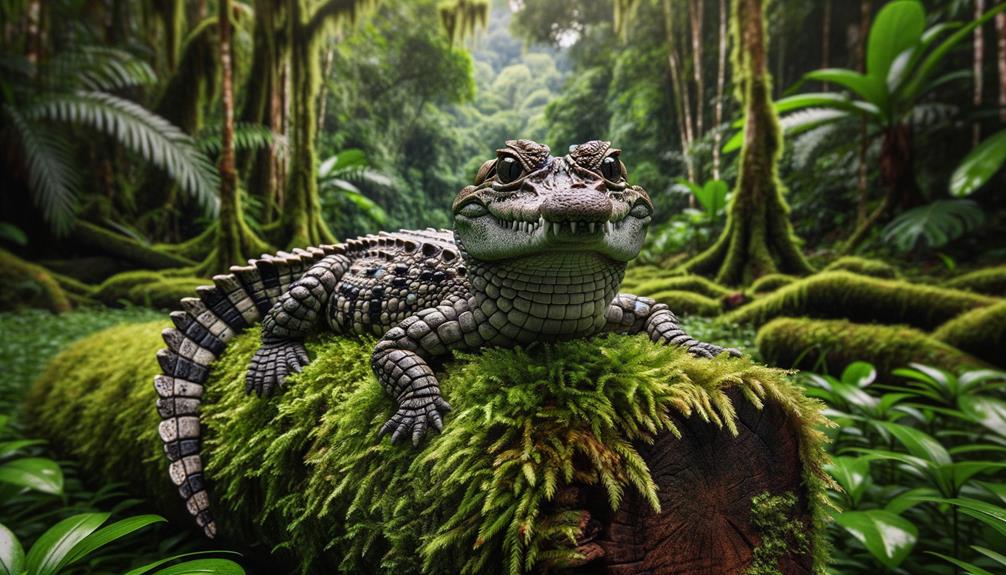
While exploring the dwarf crocodiles’ fascinating habitat, I’ve marveled at their distinct physical characteristics, such as the dome-shaped skull and the smooth, upturned snout, perfectly adapted for maneuvering through dense, forested waterways. The dwarf crocodile, or Cuvier’s caiman, stands out as the smallest member of the Crocodylidae family, with males growing up to 1.6 meters and females reaching 1.2 meters.
These crocodilian species possess a unique set of features that make them intriguing. Their strong dorsal and ventral body armor, consisting of bony osteoderms, provides robust protection against predators. Newborns even have a mucus coating that dries and reduces algal growth. Typically weighing around 6-7 kilograms, the largest recorded specimen was 1.73 meters long and weighed 37 kilograms.
| Feature | Dwarf Crocodile |
|---|---|
| Average Male Length | 1.6 meters |
| Average Female Length | 1.2 meters |
| Weight | 6-7 kilograms |
| Largest Specimen | 1.73 meters, 37 kg |
| Distinctive Skull Shape | Dome-shaped, upturned snout |
Belonging to the genus Paleosuchus, they are closely related to other South American caimans like the black caiman and share similarities with the long-snouted gharial. These physical traits are vital for their survival in their lush, forested environment.
Feeding Habits
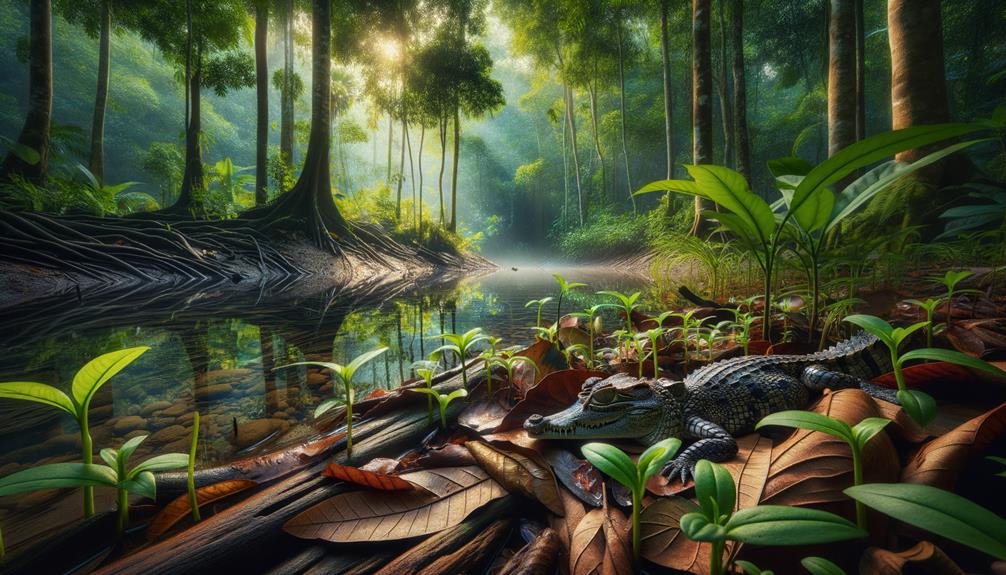
Dwarf crocodiles are opportunistic feeders with a diverse diet that includes fish, amphibians, small mammals, birds, crustaceans, molluscs, and insects. Their feeding habits are an adaptation to their environment. Juveniles feed on smaller prey like crustaceans, tadpoles, frogs, snails, and land invertebrates. As they grow, their diet shifts towards fish and small mammals.
During the dry season, these resilient creatures face significant challenges. Water sources dry up, and food becomes scarce. To survive, dwarf crocodiles aestivate in burrows, relying on stored body fat until conditions improve. This period of dormancy showcases their remarkable ability to endure hardship.
Habitat destruction poses a growing threat to their food sources. As forests are cleared and wetlands drained, the delicate balance of their ecosystem is disrupted. The loss of habitat means fewer opportunities to hunt and feed, impacting their survival.
In different regions, dwarf crocodiles exhibit dietary variations based on local prey availability. This adaptability highlights their role as essential components of their ecosystems. Understanding their feeding habits reveals how intricately these crocodiles are woven into the fabric of their habitats.
Conservation Efforts
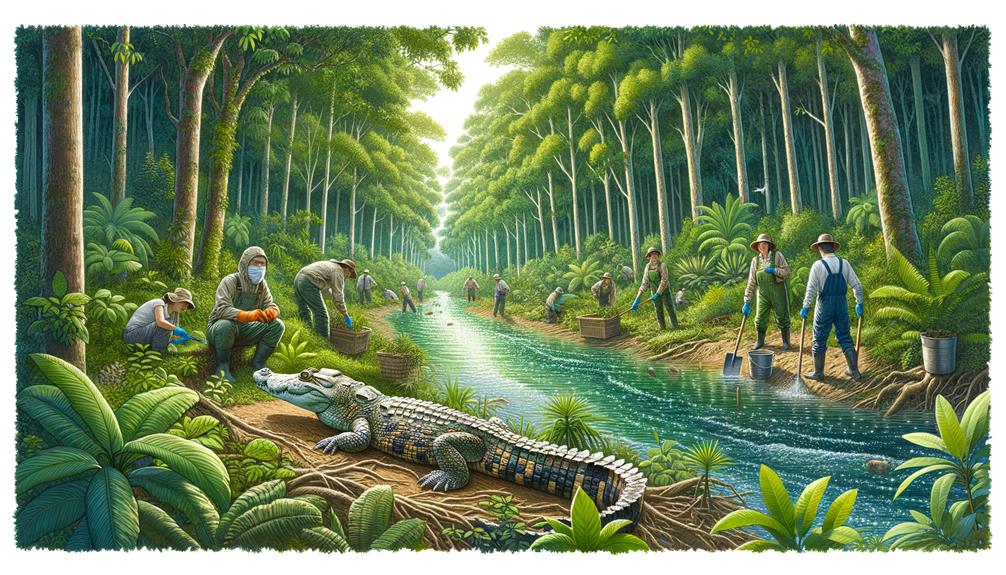
Effective conservation efforts are crucial to safeguard the remaining 2,500-10,000 mature dwarf crocodiles, as their specialized tropical forest habitats face increasing threats from deforestation and habitat loss. Organizations like the IUCN monitor these populations, classifying them as Vulnerable, which underscores the urgency of our actions.
Captive breeding programs have been vital in supplementing wild populations. One of only two successful breeding initiatives globally, these programs carefully manage the sex of the hatchlings to guarantee a balanced population. This delicate process involves precise control of incubation temperatures, which directly influence the hatchling’s gender.
Preserving habitats remains a cornerstone of our efforts. Anti-poaching patrols and sustainable ecotourism initiatives are also critical components. By collaborating with local communities, we support conservation initiatives that not only protect the dwarf crocodile but also preserve the broader rainforest ecosystem. These initiatives provide livelihoods and foster a sense of responsibility among the people who share their environment with these remarkable creatures.
Our approach combines scientific rigor with community engagement. Time is of the essence, but with concerted effort, we can ensure that these forest gems continue to thrive.
Visitor Experiences
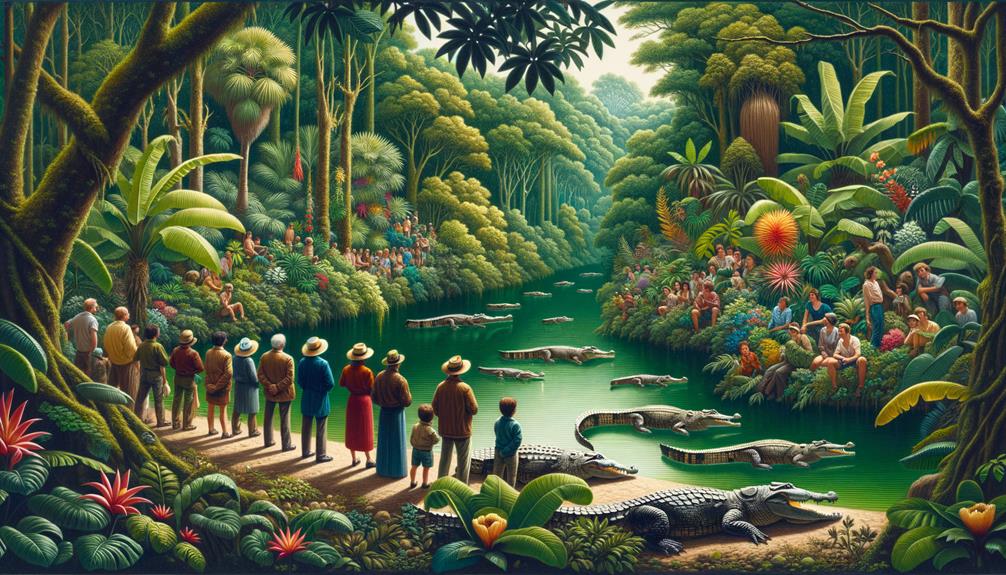
Visitors to the Living Rainforest can step into a vibrant ecosystem, observing the elusive dwarf crocodile and other incredible wildlife in their natural riverine habitat. As the smallest member of the crocodilian family, these fascinating creatures offer a rare glimpse into the delicate balance of rainforest life. Females reach sexual maturity at around 10-15 years, a critical period for conservationists working to sustain their populations.
The Living Rainforest showcases a diverse array of species beyond the dwarf crocodile. Colorful birds flit through the canopy, while Goeldi’s monkeys entertain with their curious antics. The iconic giant Amazonian waterlily, with its expansive leaves, is a testament to nature’s grandeur.
For those seeking adventure, the rainforest’s diverse edible plants, including banana, coffee, cocoa, ginger, and vanilla, reveal the interconnectedness of ecosystems and human cultures. The rainforest is a treasure trove of life-enhancing products, offering medicines, cosmetics, and building materials derived from its lush vegetation.
Frequently Asked Questions
What Are Some Interesting Facts About Dwarf Crocodiles?
Dwarf crocodiles are quite fascinating creatures. They can grow up to 1.6 meters in length, and their unique dome-shaped skulls and upturned snouts set them apart. Their diet is surprisingly diverse, ranging from fish to insects. Female dwarf crocodiles even build nests and take care of their hatchlings, showcasing their nurturing side.
How Many Dwarf Crocodiles Are Left?
Current estimates put the number of mature dwarf crocodiles in the wild between 10,000 and 100,000. Although they’re not considered endangered, their numbers are threatened by habitat loss and hunting, which highlights the need for continued conservation efforts.
Can You Keep a Dwarf Caiman as a Pet?
Keeping a dwarf caiman as a pet is a precarious endeavor. Their care requirements are multifaceted and demanding, making them unsuitable for most people. As they grow, they become powerful and challenging to handle, posing genuine risks.
What Do Dwarf Crocodiles Build Their Nests With?
Dwarf crocodiles construct their nests using a mix of vegetation and mud, creating a secure environment for their eggs. The temperature of the nest even determines the sex of the hatchlings, which I find fascinating.


